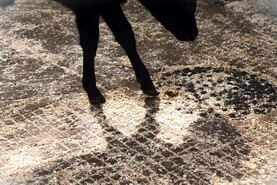It’s been another really busy week in the country’s marts, with mart managers reporting big numbers coming out, especially in the south, over the last week.
Some marts are reporting up to 20% higher numbers compared with this time last year, with some farmers taking advantage of higher prices this year and showing stock earlier than normal.
There is also the factor of less fertiliser being spread on drystock farms. This means less grass, which will mean cattle are marketed a little earlier as we proceed through the rest of the year.
Grass growth is also a little slower on some drystock farms in the south, especially where lower levels of fertiliser have been applied.
Higher numbers of cattle coming out hasn’t dampened the trade, with dry cows being the highlight of the last week. Wholesalers are extremely active driving the dry cow trade higher again this week.
A real shortage in manufacturing beef supplies is emerging and this has fed into the dry cow rings. Cows over 900kg have regularly hit €3,000 this week, with a cow weighing 910kg hitting €3,160 in Carrigallen Mart last Monday night.
Even at a 57% kill-out, she needs to come into somewhere close to €6.20/kg to get out. That’s a premium of about 70c/kg or €350/head by selling in the mart as opposed to the factory.
Taking a look at this week’s MartBids analysis table, a few red arrows have crept into the graph, but no huge movements down in a lot of cases.
Under pressure
Bullocks are under the most pressure this week, with average-quality bullocks down about 10c/kg compared with last week. The heifer trade is holding pretty steady, with top-end heifers moving up a little this week and 600kg-plus heifers continuing to trade at €3.27/kg this week.
Weanling bulls in the 300kg to 400kg category continue to work at €3.37/kg, while weanling heifers in the same weight category are working off €3.32/kg, both remaining pretty unchanged for the last week.
Live exports
There were 13,129 cattle exported out of Ireland during the week ending 14 May 2022, which takes total exports for the year to date to 172,911 head, which is an increase of 18,053 head or 12% from the corresponding period in 2021.
Livestock exports continue to perform well, with strong interest from export markets, especially northern Africa and the Middle East.
Calf exports have been helped by the return to full service of the Stena Horizon and Irish Ferries.
Reports indicate a significant tightening in cattle supplies in Northern Ireland, which may increase demand for Irish-born cattle in the region.
This increase in overall export numbers is being driven primarily by strong calf exports to continental Europe.
The Netherlands has been the stand-out market so far this year, with a significant increase from the same period last year.
Calf exports to Spain are operating at lower levels so far this year, but are expected to recover, with strong demand for calves in the market.
Smaller numbers of calves have also been exported to Italy, Northern Ireland, Belgium and Poland so far this year.






 This is a subscriber-only article
This is a subscriber-only article










SHARING OPTIONS: